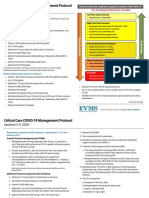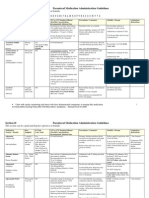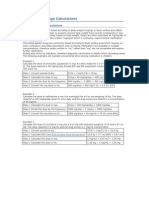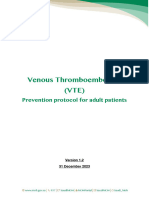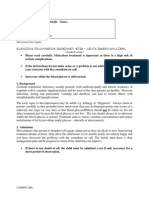Marik Covid Protocol Summary
Marik Covid Protocol Summary
Uploaded by
Caterina PrepelitaCopyright:
Available Formats
Marik Covid Protocol Summary
Marik Covid Protocol Summary
Uploaded by
Caterina PrepelitaOriginal Title
Copyright
Available Formats
Share this document
Did you find this document useful?
Is this content inappropriate?
Copyright:
Available Formats
Marik Covid Protocol Summary
Marik Covid Protocol Summary
Uploaded by
Caterina PrepelitaCopyright:
Available Formats
Critical Care COVID-19 Management Protocol General schema for respiratory support in patients with COVID-19
Please refer to the full protocol for optional treatments and explanations. TRY TO AVOID INTUBATION IF POSSIBLE
(updated 10-29-2020)
Low-Flow Nasal Cannula
Prophylaxis ■ Typically set at 1-6 Liters/Min
■ Vitamin C 500 mg BID and Quercetin 250 mg daily
B complex vitamins
High Flow Nasal Cannula
■
■ Zinc 30-50 mg/day ■ Accept permissive hypoxemia (O2 Saturation > 86%)
■ Melatonin (slow release): Begin with 0.3mg and increase as tolerated to 2 mg ■ Titrate FiO2 based on patient’s saturation
at night
■ Accept flow rates of 60 to 80 L/min
■ Vitamin D3 1000-3000 u/day
■ Trial of inhaled Flolan (epoprostenol)
■ Ivermectin for postexposure prophylaxis and weekly prophylaxis in high risk groups
(150-200 ug/kg) ■ Attempt proning (cooperative proning)
Deterioration
Mildly Symptomatic patients (at home):
Invasive Mechanical Ventilation
Recovery
■ Ivermectin 150-200 ug/kg daily for two doses
■ Target tidal volumes of ~6 cc/kg
■ Vitamin C 500mg BID and Quercetin 250-500 mg BID
■ Lowest driving pressure and PEEP
■ Vitamin D3 2000 - 4000 u/day
■ Sedation to avoid self-extubation
■ B Complex vitamins
■ Trial of inhaled Flolan
■ Zinc 75-100 mg/day
■ Melatonin 6-10 mg at night (the optimal dose is unknown)
■ ASA aspirin 81-325 mg/day (unless contraindicated)
Prone Positioning
■ Exact indication for prone ventilation is unclear
In symptomatic patients, monitoring with home pulse oximetry is recommended.
Ambulatory desaturation below 94% should prompt hospital admission
■ Consider in patients with PaO2/FiO2 ratio < 150
Mildly Symptomatic patients (on floor):
SALVAGE THERAPIES
■ Ivermectin 150-200 ug/kg daily for two doses
■ High dose corticosteroids; 120 -250 mg
■ Vitamin C 500 mg PO q 6 hourly and Quercetin 250-500 mg BID (if available) methylprednisolone q 6-8 hourly
■ Vitamin D3 20 000 – 60 000 iu single oral dose. Calcifediol 200 -500 μg is an alternative. ■ Plasma exchange
Then 20 000 iu D3 (or 200 μg calcifediol) weekly until discharged from hospital.
■ “Half-dose” rTPA
■ B complex vitamins
■ Zinc 75-100 mg/day
■ Melatonin 10 mg at night (the optimal dose is unknown) ■ Methylprednisolone 40 mg q 12 hourly; increase to 80 mg q 12 if poor response
■ Enoxaparin 60 mg daily ■ T/f EARLY to the ICU for increasing respiratory signs/symptoms and arterial
desaturations.
Find the latest version at evms.edu/covidcare continued on next page
Critical Care COVID-19 Management Protocol
(updated 10-29-2020)
Respiratory symptoms (SOB; hypoxia- requiring N/C ≥ 4 L min: Salvage Treatments
admit to ICU): ■ Plasma exchange. Should be considered in patients with progressive
Essential Treatment (dampening the STORM) oxygenation failure despite corticosteroid therapy. Patients may require up
to 5 exchanges.
1. Methylprednisolone 80 mg loading dose then 40 mg q 12 hourly for at least 7 days
and until transferred out of ICU. In patients with poor response, increase to 80-125 ■ High dose corticosteroids; Bolus 250- 500mg/ day methylprednisolone
mg q 12 hourly. ■ Half-dose rTPA
2. Ascorbic acid (Vitamin C) 3g IV q 6 hourly for at least 7 days and/or until ■ ECMO
transferred out of ICU. Note caution with POC glucose testing. Monitoring:
3. Full anticoagulation: Unless contraindicated we suggest FULL ■ On admission: PCT, CRP, BNP, Troponins, Ferritin, Neutrophil-Lymphocyte
anticoagulation (on admission to the ICU) with enoxaparin, i.e 1 mg kg s/c ratio, D-dimer and Mg.
q 12 hourly (dose adjust with Cr Cl < 30mls/min). Heparin is suggested with ■ Daily: CRP, Ferritin, D-Dimer and PCT. CRP and Ferritin track disease severity
CrCl < 15 ml/min. closely (although ferritin tends to lag behind CRP).
Note: Early termination of ascorbic acid and corticosteroids will likely result in a ■ In patients receiving IV vitamin C, the Accu-Chek™ POC glucose monitor
rebound effect.
will result in spuriously high blood glucose values. Therefore, a laboratory
Additional Treatment Components (the Full Monty) glucose is recommended to confirm the blood glucose levels
4. Ivermectin 150-200 ug/kg daily for two doses Post ICU management
5. Vitamin D3 20 000 – 60 000 iu single oral dose. Calcifediol 200 -500 μg ■ Enoxaparin 40-60 mg s/c daily
is an alternative. Then 20 000 iu D3 (or 200 μg calcifediol) weekly until ■ Methylprednisone 40 mg day, then wean slowly
discharged from hospital. ■ Vitamin C 500 mg PO BID
6. Thiamine 200 mg IV q 12 hourly ■ Melatonin 3-6 mg at night
7. B complex vitamins
Post hospital discharge
8. Zinc 75-100 mg/day
1. Consider extended DVT prophylaxis in high risk patients.
9. Melatonin 10 mg at night (the optimal dose is unknown).
2. Consider tapering course of corticosteroids (guided by CRP)
10. Atorvastatin 80mg/day 3. Omega-3 fatty acids
11. Escalation of respiratory support; See General Schema for Respiratory 4. Atorvastatin 40mg daily
Support in Patients with COVID-19.
5. Melatonin
6. Multivitamins including B complex and Vitamin D
Find the latest version at evms.edu/covidcare Developed and updated by Paul Marik, MD, Chief of Pulmonary and Critical Care Medicine, Eastern Virginia Medical School, Norfolk, VA
You might also like
- Ultimate Orgasm TechniquesDocument91 pagesUltimate Orgasm Techniquesmeibook44% (73)
- Pediatric Emergency Pocket GuideDocument2 pagesPediatric Emergency Pocket GuideHongMingNo ratings yet
- Clinical Cases Pharmacology PDFDocument7 pagesClinical Cases Pharmacology PDFAnkur HazraNo ratings yet
- Contrast Reaction Card PediatricDocument2 pagesContrast Reaction Card PediatricJenniffer FlorenciaNo ratings yet
- ACLS Pocket GuideDocument5 pagesACLS Pocket Guidedragnu100% (1)
- Tao Yin Han & The Six Healing Sounds - Qigong Kung Luohan (First Section Book 1)Document66 pagesTao Yin Han & The Six Healing Sounds - Qigong Kung Luohan (First Section Book 1)pompona100% (1)
- Amna Adcp Case ReportDocument67 pagesAmna Adcp Case ReportAmna Sher Ali ShakerNo ratings yet
- Marik Covid Protocol SummaryDocument2 pagesMarik Covid Protocol SummaryCamille05No ratings yet
- Marik Covid Protocol SummaryDocument2 pagesMarik Covid Protocol SummaryelasticemperorNo ratings yet
- Marik Covid Protocol SummaryDocument2 pagesMarik Covid Protocol SummaryInternos YopalNo ratings yet
- Marik Covid Protocol Summary PDFDocument2 pagesMarik Covid Protocol Summary PDFJody VivasNo ratings yet
- Marik Covid Protocol SummaryDocument2 pagesMarik Covid Protocol Summaryshubham rathodNo ratings yet
- Marik Covid Protocol Summary PDFDocument1 pageMarik Covid Protocol Summary PDFCiuvat Dumitru ValentinNo ratings yet
- FLCCC Alliance MATHplus Protocol ENGLISHDocument2 pagesFLCCC Alliance MATHplus Protocol ENGLISHBhanu Kumar100% (1)
- ACLS Algorithms Adult 2010Document12 pagesACLS Algorithms Adult 2010anon_336736395No ratings yet
- COVID MX BsmmuDocument2 pagesCOVID MX BsmmuNuhiat NahreenNo ratings yet
- Hospital Treatment Protocol For Covid-19Document4 pagesHospital Treatment Protocol For Covid-19Adrian BoboceaNo ratings yet
- Acls Algorithms 2012Document12 pagesAcls Algorithms 2012Prashanth KumarNo ratings yet
- Acls Algorithms 2012Document12 pagesAcls Algorithms 2012kivuNo ratings yet
- FLCCC Alliance MATHplus Protocol ENGLISHDocument3 pagesFLCCC Alliance MATHplus Protocol ENGLISHJhonn BlackNo ratings yet
- FLCCC Alliance MATHplus Protocol ENGLISHDocument3 pagesFLCCC Alliance MATHplus Protocol ENGLISHfernandohNo ratings yet
- CCF IpDocument1 pageCCF IpBryan FjbNo ratings yet
- Medication Administration PolicyDocument76 pagesMedication Administration PolicyJully GaciasNo ratings yet
- AIIMS COVID Algorithm 1.5-1 PDFDocument1 pageAIIMS COVID Algorithm 1.5-1 PDFAnutosh BhaskarNo ratings yet
- CNS: Ent:: Review Antibiotic Therapy Daily - Can You: Stop? Switch? Simplify? or State Duration?Document1 pageCNS: Ent:: Review Antibiotic Therapy Daily - Can You: Stop? Switch? Simplify? or State Duration?Fitri RachmadaniNo ratings yet
- FLCCC Alliance MATHplus Protocol ENGLISHDocument3 pagesFLCCC Alliance MATHplus Protocol ENGLISHDavid GrayNo ratings yet
- VTE-Prophylaxis-Protocol - MOHDocument13 pagesVTE-Prophylaxis-Protocol - MOHreham ONo ratings yet
- NICU Drugs GuideDocument49 pagesNICU Drugs GuideArhan100% (1)
- BMC COVID Anticoagulation Algorithm Update 5 1 20Document1 pageBMC COVID Anticoagulation Algorithm Update 5 1 20Avinash KumbharNo ratings yet
- Antibiotic Protocol 2018Document10 pagesAntibiotic Protocol 2018sumayyah995No ratings yet
- Paediatric Advanced Life Support: Call For Help 2222 Commence/continue CPR (5 Initial Breaths Then CV Ratio 15:2)Document1 pagePaediatric Advanced Life Support: Call For Help 2222 Commence/continue CPR (5 Initial Breaths Then CV Ratio 15:2)Vijay RNo ratings yet
- Farma StrokeDocument37 pagesFarma StrokeDAHLIANo ratings yet
- Drugs in ICUDocument15 pagesDrugs in ICUalaasaidali3No ratings yet
- Seven Ps For RSI BOARDDocument2 pagesSeven Ps For RSI BOARDJames BrownNo ratings yet
- Drugs in PregnancyDocument40 pagesDrugs in PregnancyhkkanhaNo ratings yet
- Atrial Fibrillation TDDocument6 pagesAtrial Fibrillation TDapi-594366475No ratings yet
- Adult Cardiac Arrest Circular Algorithm: Monitor CPR QualityDocument1 pageAdult Cardiac Arrest Circular Algorithm: Monitor CPR QualityAlexis HospitalNo ratings yet
- Adult Cardiac Arrest Circular Algorithm: Monitor CPR QualityDocument1 pageAdult Cardiac Arrest Circular Algorithm: Monitor CPR QualityChris LeeNo ratings yet
- AlgorithmACLS CA Circular 200612 240608 094017Document1 pageAlgorithmACLS CA Circular 200612 240608 094017Omar José González ObandoNo ratings yet
- Electrolyte Prescribe Gline AdultDocument2 pagesElectrolyte Prescribe Gline AdultMirelaNo ratings yet
- CMSCN R IgevDocument2 pagesCMSCN R Igevdiana8827534No ratings yet
- Status EPilepticusDocument12 pagesStatus EPilepticusDhanush PNo ratings yet
- Contrast Reaction Card PediatricDocument2 pagesContrast Reaction Card PediatricschristinaNo ratings yet
- Newer Oral Anticoagulant: DR Shivaom Chaurasia Resident Internal MedicineDocument57 pagesNewer Oral Anticoagulant: DR Shivaom Chaurasia Resident Internal MedicineMuhammad Reza FirdausNo ratings yet
- Antibiotics & Analgesics Used in DentistryDocument4 pagesAntibiotics & Analgesics Used in DentistryDominique AbelaNo ratings yet
- ICE DrugsDocument2 pagesICE DrugsRichelle FrondaNo ratings yet
- Antimicrobial Dosage Adjustments in Renal Impairment For FormularyDocument20 pagesAntimicrobial Dosage Adjustments in Renal Impairment For Formularyangkatanjuli2019No ratings yet
- CPR PosterDocument1 pageCPR PosterHemantNo ratings yet
- Pediatric Dosage CalculationsDocument5 pagesPediatric Dosage CalculationsLovely Anjenell MacalingaNo ratings yet
- Moonlighting Cheat SheetDocument21 pagesMoonlighting Cheat SheetseconyeartransNo ratings yet
- CH 8Document12 pagesCH 8Олександр РабошукNo ratings yet
- Medad TeamDocument18 pagesMedad TeamAxmed MaxamedNo ratings yet
- AtropinDocument9 pagesAtropinarfitaaaaNo ratings yet
- VTE Prophylaxis PROTOCOL V1.2 Withforms 31 Dec 2023Document19 pagesVTE Prophylaxis PROTOCOL V1.2 Withforms 31 Dec 2023hatem newishyNo ratings yet
- Moderately HighLY Protein Bound DrugsDocument10 pagesModerately HighLY Protein Bound DrugsArah MomoNo ratings yet
- Phenytoin Administration GuideDocument2 pagesPhenytoin Administration GuideNoorHaziqZ1926No ratings yet
- Critical Care Medications: Anti-Arrhythmics Study Guide: Critical Care EssentialsFrom EverandCritical Care Medications: Anti-Arrhythmics Study Guide: Critical Care EssentialsNo ratings yet
- Top 100 Drugs Pocket Reference Guide (2023 Edition)From EverandTop 100 Drugs Pocket Reference Guide (2023 Edition)No ratings yet
- Critical Care Medications: Vasopressors, Inotropes and Anti-Hypertensives Study Guide: Critical Care EssentialsFrom EverandCritical Care Medications: Vasopressors, Inotropes and Anti-Hypertensives Study Guide: Critical Care EssentialsNo ratings yet
- Event1 Jurnalul Pediatrului Supliment 1 2011Document30 pagesEvent1 Jurnalul Pediatrului Supliment 1 2011Caterina PrepelitaNo ratings yet
- Contact Details Name: Hospital Telephone:: This Protocol Has 4 PagesDocument4 pagesContact Details Name: Hospital Telephone:: This Protocol Has 4 PagesCaterina PrepelitaNo ratings yet
- Contact Details Name: Hospital Telephone:: This Protocol Has 4 PagesDocument4 pagesContact Details Name: Hospital Telephone:: This Protocol Has 4 PagesCaterina PrepelitaNo ratings yet
- Contact Details Name: Hospital Telephone:: Treatment Is Urgent. Do Not DelayDocument4 pagesContact Details Name: Hospital Telephone:: Treatment Is Urgent. Do Not DelayCaterina PrepelitaNo ratings yet
- This Protocol Has 4 Pages: Acute DecompensationDocument4 pagesThis Protocol Has 4 Pages: Acute DecompensationCaterina PrepelitaNo ratings yet
- Contact Details Name: Hospital Telephone:: Carnitine Transporter Deficiency (CTD) - Acute DecompensationDocument4 pagesContact Details Name: Hospital Telephone:: Carnitine Transporter Deficiency (CTD) - Acute DecompensationCaterina PrepelitaNo ratings yet
- ER A&ECitrin1 119909 22 05 2013Document1 pageER A&ECitrin1 119909 22 05 2013Caterina PrepelitaNo ratings yet
- Cyclical Vomitingv1 235142 22 05 2013Document1 pageCyclical Vomitingv1 235142 22 05 2013Caterina PrepelitaNo ratings yet
- Biomedical Waste Amid Covid19Document1 pageBiomedical Waste Amid Covid19SynthiaNo ratings yet
- Challenges in NursingDocument4 pagesChallenges in NursingAnju PandeyNo ratings yet
- Instructions On Usage of Toilet PaperDocument11 pagesInstructions On Usage of Toilet PaperA.R.AthreyaNo ratings yet
- Bomba - ITT - Família 3175Document102 pagesBomba - ITT - Família 3175UezilheiNo ratings yet
- GW01 Municipal Water Purification SystemsDocument3 pagesGW01 Municipal Water Purification SystemsKumbokarno SoloensisNo ratings yet
- STD V Lesson PlanDocument20 pagesSTD V Lesson PlanSnehal Bhonde NikaljeNo ratings yet
- Iktiosis Harlequin Di Manado - Laporan Kasus: Triomega F. X. Sengkey, Aryani Adji, Grace M. Kapantow, Johny RompisDocument7 pagesIktiosis Harlequin Di Manado - Laporan Kasus: Triomega F. X. Sengkey, Aryani Adji, Grace M. Kapantow, Johny RompisAldoNo ratings yet
- Dokumen - Tips - Contoh CV HsedocDocument3 pagesDokumen - Tips - Contoh CV HsedocsufizamaniNo ratings yet
- Modified Galvanic Current: DR Riaz Ahmed PT LecturerDocument23 pagesModified Galvanic Current: DR Riaz Ahmed PT LecturerMichael SelvarajNo ratings yet
- GMP SsopDocument98 pagesGMP SsopNicoel100% (22)
- TTBR 06 May 2024 DDocument26 pagesTTBR 06 May 2024 DHarshNo ratings yet
- IEP Presentation Slide ShowDocument20 pagesIEP Presentation Slide ShowJianhua ShiNo ratings yet
- Diagnostic Parent Rating Scale 1Document3 pagesDiagnostic Parent Rating Scale 1Yet Barreda Basbas100% (2)
- 2013 Table 1 Mobility and Functional Assessment Tools PDFDocument4 pages2013 Table 1 Mobility and Functional Assessment Tools PDFesbat07No ratings yet
- Eleven Star WorkingDocument13 pagesEleven Star WorkingRobin SimonNo ratings yet
- Nursing Care Plan: Assessment Diagnosis Planning Interventions Rationale EvaluationDocument2 pagesNursing Care Plan: Assessment Diagnosis Planning Interventions Rationale EvaluationMina Sumaoang0% (1)
- How A Global Pandemic Changed The Way We TravelDocument21 pagesHow A Global Pandemic Changed The Way We TravelCharlene KronstedtNo ratings yet
- GK1 - Luong The VinhDocument6 pagesGK1 - Luong The VinhQuaNo ratings yet
- The ProblemDocument17 pagesThe ProblemJose BenaventeNo ratings yet
- ILO SafeDay24 ReportDocument132 pagesILO SafeDay24 ReportseanaluderNo ratings yet
- Public Health UnitDocument2 pagesPublic Health UnitMark Emil BautistaNo ratings yet
- Common Board QuestionsDocument6 pagesCommon Board QuestionsRafael BasaNo ratings yet
- Projekat Svet U Srbiji 2014 15 Word in Serbia 14 15Document2 pagesProjekat Svet U Srbiji 2014 15 Word in Serbia 14 15Ummu masyithotul KhoiriyahNo ratings yet
- 11.safety Excellence Wheel Scoring Record Action PlanDocument3 pages11.safety Excellence Wheel Scoring Record Action PlanSimbolon RichardNo ratings yet
- Lab 2Document11 pagesLab 2api-300103665No ratings yet
- Peace Corps TG 545 Sexual Assault PTSD Assessment Mental Health Assessment and CareDocument15 pagesPeace Corps TG 545 Sexual Assault PTSD Assessment Mental Health Assessment and CareAccessible Journal Media: Peace Corps DocumentsNo ratings yet
- Mental Health SurveyDocument5 pagesMental Health SurveyB 40 Rishabh ParmarNo ratings yet







